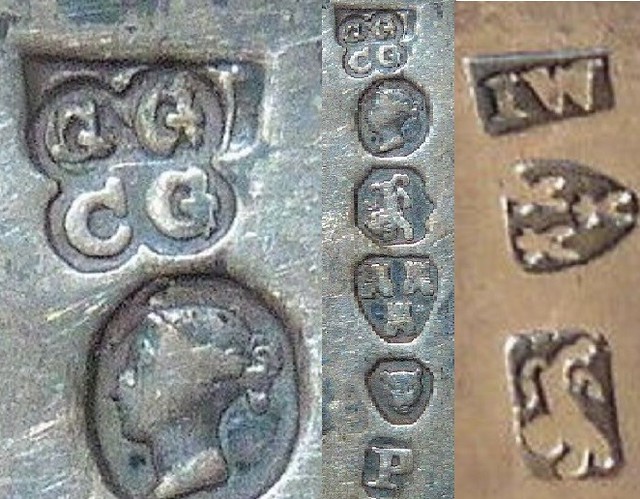

They entered their marks at the Newcastle Assay Office on the 30th July 1852 as 'George Gowland and Brother Goldsmith'. For the alternative mark registered by them see: http://www.925-1000.com/dlNewcastle.html" onclick="window.open(this.href);return false;
It is the maker's mark that makes this spoon of interest for in 1866, according to the Newcastle assay ledgers, the Gowland Brothers never made any submissions, nor did they make any during any other year. Close inspection reveals no evidence of an overstrike.
The Gowland brothers were the sons of Clement Gowland I (we'll call him I although his father, also Clement was a noted clock & watchmaker). Clement Gowland I entered his mark with NAO on the 19th August 1845, the address at entry was given as 178, High Street, Bishop Wearmouth, which is now a suberb of Sunderland. Like his sons there appears to be no submissions for assay at Newcastle. Clement (I) was married in 1828 to Jane Hay and was the brother-in-law to the well known Newcastle silversmith William Lister. He is thought to have retired around 1851-2 and died around 1859-60.
Following their fathers retirement the sons took over the business and entered into partnership, useing the same address as their father.
The 1861 census details George as married to Mary and having four children and two servants and the 1881 census shows that he had six children with all three sons described as 'Jeweller's assistants'. In 1867 George entered his mark at the London Assay Office.
So how can any of the Gowland's marks be found on silverware when there is no record of assay? The ledgers at Newcastle are complete at this period, so in theory the spoon shown above cannot exist, but of course it does and other items made by the Gowlands have been noted. The reason why it happened is surely just human nature, the Assaymasters at Newcastle during this period were Francis Sommerville then James Robson, neither were on a fixed salary and were dependant on the fees they received for marking and the percentage of the Duty that they were paid for collecting it. It was part of the Assaymaster's duties at Newcastle to keep the accounts and it appears that there was no check on the accounts with the exception of a comprasion with the assay ledger that was made by the Stamp Office, there were no daily reports and the Assaymaster made up the books quarterly.
The Assaymaster still has to eat during periods when little work is being assayed.
Trev.
.


